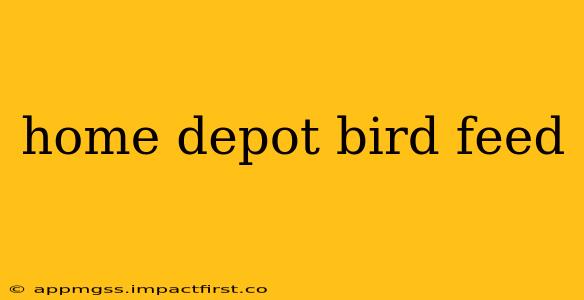Are you looking to bring a vibrant splash of color and cheerful chirping to your backyard? Setting up a bird feeder is a fantastic way to enjoy the beauty of nature up close. Home Depot offers a wide selection of bird feeders, making it easy to find the perfect one for your needs. This guide will delve into everything you need to know about choosing and using bird feeders from Home Depot, answering frequently asked questions along the way.
What types of bird feeders does Home Depot carry?
Home Depot boasts a diverse range of bird feeders catering to different bird species and preferences. You'll find various styles, including:
- Tube feeders: These are popular choices, often featuring multiple feeding ports to accommodate several birds simultaneously. They are typically filled with seeds, sunflower seeds being a particular favorite.
- Hopper feeders: These larger feeders hold a substantial amount of seed, reducing the frequency of refills. They often have a protective roof to shield the seed from the elements.
- Suet feeders: Designed to hold suet cakes (a high-energy food source for birds), these feeders are particularly attractive during colder months when natural food sources are scarce.
- Platform feeders: These simple, open feeders are ideal for birds that prefer to feed on the ground or a flat surface. They're great for larger birds like doves and jays.
What kind of birdseed should I use with my Home Depot bird feeder?
Choosing the right birdseed is crucial for attracting a diverse range of birds. Home Depot usually offers a variety of seed blends, but some popular options include:
- Black oil sunflower seeds: A favorite among many bird species due to their high oil content and nutritional value.
- White-striped sunflower seeds: A slightly cheaper alternative to black oil sunflower seeds, still attractive to numerous birds.
- Nyjer seeds (thistle): Specifically designed to attract smaller birds like goldfinches.
- Mixed seed blends: These blends often contain a variety of seeds, attracting a wider variety of birds.
Remember to choose a seed blend appropriate for the type of feeder you have and the birds you wish to attract.
How do I clean my Home Depot bird feeder?
Regular cleaning is essential to prevent the spread of disease among your feathered visitors. Here's a simple cleaning routine:
- Empty the feeder: Remove all seeds and debris.
- Wash thoroughly: Use warm, soapy water to clean all parts of the feeder. Avoid using harsh chemicals.
- Rinse completely: Ensure all soap residue is removed.
- Dry thoroughly: Allow the feeder to air dry completely before refilling.
It's recommended to clean your bird feeder at least once a month, or more frequently during warmer months.
Where is the best place to put a bird feeder?
Placement is key to attracting birds and ensuring their safety. Consider these factors:
- Visibility: Place the feeder in a visible location, but away from windows to prevent collisions.
- Shelter: Offer some protection from the elements, like a nearby tree or bush.
- Predator protection: Place the feeder away from potential predators like cats.
- Accessibility: Ensure easy access for refilling and cleaning.
How often should I refill my Home Depot bird feeder?
Refilling frequency depends on the size of your feeder, the number of birds visiting, and the type of seed used. Monitor your feeder regularly and refill when the seed level gets low. This prevents birds from going hungry and keeps them coming back.
By following these simple guidelines and choosing the right feeder and seed from Home Depot, you can create a thriving bird sanctuary in your backyard, enjoying the beauty and sounds of nature from the comfort of your home. Remember to regularly maintain your feeder for the health and well-being of your feathered friends.
